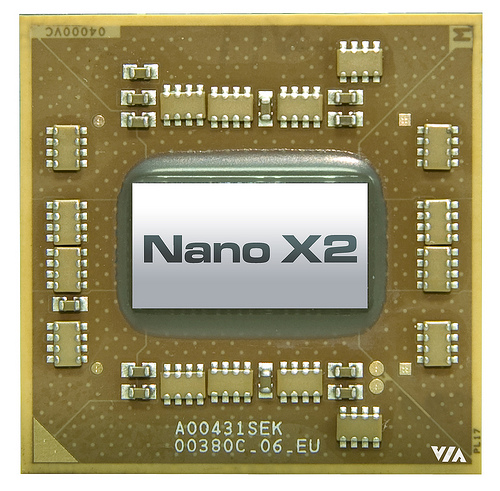VIA Dual-Core Nano Launches But Availability An Open Question
VIA Technologies formally announced that its new dual-core, 40nm Nano X2 processors have been released. At present, processors are available to motherboards and OEMs, with systems available in Q1 of 2011. VIA will most likely have at least a few motherboards and notebooks/netbooks on display at CES, but the company has yet to name any major partners for these products.
"The VIA Nano X2 processor arrives at a time when software architectures are now optimized for multi-thread computing," commented Richard Brown, VP International Marketing, VIA Technologies, Inc. "Improvements in semi-conductor fabrication means we can now double the number of processor cores while maintaining the same low energy consumption levels that our customers are used to."

VIA's new core pairs two Nano 3000 processors either on the same die or via MCM
We previewed the Nano X2 back in early November, but need to amend that article in one significant way. While the Nano's architecture hasn't changed much according to VIA's spec sheets, the Nano X2 is based on the Nano 3000 core, not the original Nano 2000 series products that VIA distributed to reviewers back in the summer of 2008.
The 3000 series improved the Isaiah architecture's execution and L1/L2 cache efficiency, took advantage of certain foundry optimizations to lower overall power consumption, and improved performance ~20 percent clock-for-clock. It's this core that the X2 series is based on, which means that Nano could still potentially compete well vis-à-vis Intel's Atom or even AMD's Bobcat. By building on TSMC's now-mature 40nm process and adopting the newer Isaiah core, VIA should be able to able to offer processors at clockspeeds comparable to both of its competitors without sacrificing much in the way of battery life.
Whether or not we'll actually see retail products, however, is anyone's guess. Reviewers were quite positive about Nano's potential when VIA sampled it during the summer of 2008 but the CPU all-but-vanished thereafter. During that summer VIA stated several times that the second-generation HP Mini-Note 2133 would feature a Nano rather than a C7, but HP ultimately tapped Intel's Atom when it announced the HP Mini-2140. As far as we're aware, Samsung's NC20 was the most visible Nano-based netbook out of the scant handful that shipped to the US.
The Nano X2 still has a chance to make its mark, but 2.5 years later the ultra-mobile market is much changed from what it was when netbooks were king and Atom the only show in town. Hopefully things play out differently the second time around.
"The VIA Nano X2 processor arrives at a time when software architectures are now optimized for multi-thread computing," commented Richard Brown, VP International Marketing, VIA Technologies, Inc. "Improvements in semi-conductor fabrication means we can now double the number of processor cores while maintaining the same low energy consumption levels that our customers are used to."

VIA's new core pairs two Nano 3000 processors either on the same die or via MCM
We previewed the Nano X2 back in early November, but need to amend that article in one significant way. While the Nano's architecture hasn't changed much according to VIA's spec sheets, the Nano X2 is based on the Nano 3000 core, not the original Nano 2000 series products that VIA distributed to reviewers back in the summer of 2008.
The 3000 series improved the Isaiah architecture's execution and L1/L2 cache efficiency, took advantage of certain foundry optimizations to lower overall power consumption, and improved performance ~20 percent clock-for-clock. It's this core that the X2 series is based on, which means that Nano could still potentially compete well vis-à-vis Intel's Atom or even AMD's Bobcat. By building on TSMC's now-mature 40nm process and adopting the newer Isaiah core, VIA should be able to able to offer processors at clockspeeds comparable to both of its competitors without sacrificing much in the way of battery life.
Whether or not we'll actually see retail products, however, is anyone's guess. Reviewers were quite positive about Nano's potential when VIA sampled it during the summer of 2008 but the CPU all-but-vanished thereafter. During that summer VIA stated several times that the second-generation HP Mini-Note 2133 would feature a Nano rather than a C7, but HP ultimately tapped Intel's Atom when it announced the HP Mini-2140. As far as we're aware, Samsung's NC20 was the most visible Nano-based netbook out of the scant handful that shipped to the US.
The Nano X2 still has a chance to make its mark, but 2.5 years later the ultra-mobile market is much changed from what it was when netbooks were king and Atom the only show in town. Hopefully things play out differently the second time around.

